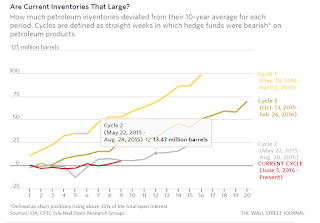Below is my response to an article entitled "
The Oil Industry Faces a Grim Future?"
I disagree. I believe this analysis is incorrect.
What happens to a market when prices are held above the long run inflation adjusted cost for extended period of time? You get surpluses. What happens when you get surpluses? Prices decline. What happens when you get price declines? Inefficient companies (and in this case countries) go bankrupt. This is all economics 101.
Prices are not low, they are within on standard deviation of the long run inflation adjusted prices per barrel. The 2006-2011 prices were historically high on an inflation adjusted basis.
The long run mean inflation adjusted price of a barrel of oil from 1946 (Post war period) in 2015 dollars is $41/barrel, since 1980 it is $51. The price is barely below the mean of the last 36 years and above the mean for the past 70 years. This mean is also biased to the upside due to cartel behavior. A free market, like the one that is developing would have had a lower inflation adjusted price.
The low price narrative that is continually being repeated is to disguise poor capital allocation decisions, the inability to control costs and the reluctance to adopt technology.
Currently what is happening is that producers who were able to free ride on inefficient and cartel behavior are being forced to adjust a free market in oil. In a few years costs will be lower for those that survive and those that cannot reduce costs they will disappear.
The energy business has historically been slow to adopt new technology and methods. This forced adjustment to a free market will accelerate the adoption of technology. Directional drilling was first used in the 1930s but only adopted in 2000s and wells have been fracked since the 1940s, the AAPG released a paper in the 1950s discussing the first 10 years of this practice. It took 70 years to combine the two. No other industry would survive adopting technology and change this slow. The only reason why is 100 years of oligopoly (Texas Railroad Commission followed by OPEC).
Because prices were held above the marginal cost of production due to the cartel effect producers were to free ride and be inefficient. This is essentially no different than what the automakers had to adjust to when the Japanese gained market share in the 1980s. But to claim costs are low is incorrect and forecast dire straits ad infinitum bears the semblance of the predictions of the end of the US automakers in 1980.
Further using the peak oil declining EROEI argument also ignores history. When Col. Drake drilled the first well into a “conventional” reservoir in the 1860s the EREOI was very low, maybe negative. However, over time the EREOI improved. To compare “unconventional” production or oil sands today versus conventional wells in Saudi Arabia that have had continual, but slow technology improvements over the past 70 years is to assume that the EREOI is static and not dynamic. EREOI for oil sands has improved since the 1950s, and unconventional EREOI has improved just in the past 5 years. Unless you can tell me what the return on energy will be for a SAGD project when they begin using microwaves to reduce bitumen viscosity and eliminate the need for natural gas, then the EREOI argument is a strawman. It is like comparing baseball players of today versus the 1890s, fun over a drink but a waste of time.
Some historical perspective is required in analysis. The issue is not that prices are low, poor capital decisions were made when prices were historically high. The world is not ending. The sector is fine. All that is happening is the normal transition from a cartel dominated oligopoly priced market to a free market. Its economics 101.
Charts of the inflation adjusted price of a barrel of crude oil
http://inflationdata.com/Inflation/Inflation_Rate/Historical_Oil_Prices_Chart.asp
http://www.macrotrends.net/1369/crude-oil-price-history-chart










